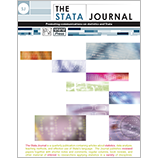Rate decomposition for aggregate data using Das Gupta's method
Jinjing Li
National Centre for Social and Economic Modelling
Institute for Governance and Policy Analysis
University of Canberra
Bruce, Australia
[email protected]
|
Abstract. Social, behavioral, and health scientists frequently decompose changes or
differences in outcome variables into components of change and assess their
relative importance. Many Stata commands facilitate this exercise using
unit-level data, notably by applying the Blinder–Oaxaca approach.
However, none of the comparable user-written commands decompose changes or
differences in aggregate data despite their availability and the widespread use
of corresponding decomposition techniques. In this article, I present the
user-written command rdecompose, which decomposes aggregate or
cross-classified data based on Das Gupta's (1993, Standardization and
Decomposition of Rates: A User’s Manual, Volume 1) approach, and
demonstrate its application in multiple settings. This command extends the
original method by allowing multiple factors and flexible functional
specifications.
View all articles by this author:
Jinjing Li
View all articles with these keywords:
rdecompose, decomposition, cross-classified, Das Gupta method
Download citation: BibTeX RIS
Download citation and abstract: BibTeX RIS
|
